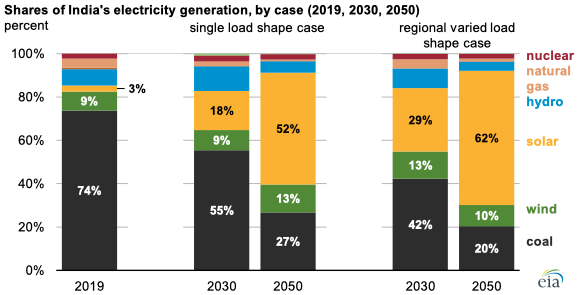Interregional electricity trade in India affects shares of solar and coal-fired generation
Nov 13, 2020With more than 1.3 billion people, India is the second-most populous country in the world and has the third-highest energy consumption level after China and the United States. To help meet the country’s energy needs, India is expanding its electric transmission infrastructure to improve electricity movement between regions of the country. In the International Energy Outlook 2020 (IEO2020), the U.S. Energy Information Administration (EIA) considers how interregional electricity grid connections could influence India’s future electricity generating fuel choices. EIA’s modeling shows that greater levels of grid connectivity and electricity trade between regions result in more electricity generation from solar and less from coal.

In the past, EIA modeled India’s power market as one region with a single load shape, meaning EIA assumed electricity customers across the country consumed electricity at the same hourly, daily, and seasonal rates. For IEO2020, EIA modeled India’s power market as five distinct regions, representing the country’s five regional power grids. Modeling the power market using five regions better captures the effect of regional electricity transmission interconnections on capacity expansion decisions and longer-term fuel demands for India’s power sector.
Each region’s electricity use varies by time of day and season because climates and local economies differ across India. To capture the differences in regional electricity use, EIA uses regional load shapes that reflect seasonal and daily variation in electricity consumption. In addition, the mix of power plant technologies and generating fuel prices, such as coal and natural gas prices, varies between regions.
EIA found that using five regions when modeling India’s electricity market and varying load shapes by region led to a large amount of interregional electricity movement. When electricity moves between power regions, regions with excess electricity can move relatively lower cost electricity, such as wind- or solar-generated electricity, to regions that need more. Without these movements, regions needing more electricity usually meet demand with higher cost generation, often from fossil fuel sources.
Because the lower cost of electricity resulting from movement between regions makes up for the initial cost of adding the necessary transmission capacity, EIA expects interregional movements to increase, which will affect the sources India chooses to generate electricity. With more electricity movement across regions, India’s electricity mix would shift to a larger share of solar generation and a lower share of coal.
Principal contributor: Lori Aniti
Similar Stories

Rising data demand puts pressure on US energy grid, boosts gas projects / Rystad Energy
View Article
EIA extends five key energy forecasts through December 2026
View Article
New interagency study finds expansion of renewable energy production on federal lands could power millions more American homes
View ArticleEIA Short-Term Energy Outlook
This edition of our STEO is the first to include forecasts for 2026.
View Article
EIA publishes its first energy-sector forecasts through 2026
View Article
The eighth U.S. liquefied natural gas export terminal, Plaquemines LNG, ships first cargo
View ArticleGet the most up-to-date trending news!
SubscribeIndustry updates and weekly newsletter direct to your inbox!





